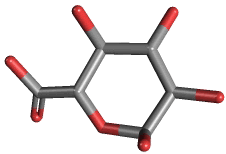|
D-GLUCURONIC ACID |
| Synonyms. D-Glucuronic acid; (2S,3S,4S,5R,6S)-3,4,5,6-Tetrahydroxytetrahydro-2H-pyran-2-carboxylic acid; Glucuronic acid; (2S,3S,4S,5R,6R)-3,4,5,6-Tetrahydroxyoxane-2-carboxylic acid; alpha-D-Glucopyranuronic acid; Glucosiduronate; |
|
|
| PRODUCT IDENTIFICATION | |
|
CAS RN |
6556-12-3 |
|
EINECS RN |
229-486-4 |
|
FORMULA |
C6H10O7 |
|
MOLE WEIGHT |
194.14 |
|
H.S CODE |
2932.99.9090 |
|
SMILES |
C(=O)[C@H](O)[C@H]([C@@H]([C@@H](C(O)=O)O)O)O |
|
CLASSIFICATION |
Hepatology, Sugar acid |
|
EXTRA NOTES |
Other RN: 12758-41-7, 36116-79-7, 87090-89-9, 87246-82-0 |
|
|
| PHYSICAL AND CHEMICAL PROPERTIES | |
|
PHYSICAL STATE |
white to off-white crystalline powder |
|
MELTING POINT |
165 C |
|
BOILING POINT |
|
|
DENSITY |
|
|
SOLUBILITY IN WATER |
|
| SOLVENT SOLUBILITY |
|
|
VAPOR DENSITY |
|
|
log P(octanol-water) |
-2.57 |
|
VAPOR PRESSURE |
7.39E-10 mm Hg |
|
AUTOIGNITION TEMP |
|
| pK |
|
|
REFRACTIVE INDEX |
(n20/D) |
|
FLASH POINT |
|
|
|
| STABILITY AND REACTIVITY | |
| STABILITY | Stable under normal conditions. |
|
INCOMPATIBLE MATERIALS |
Strong oxidizing agents. |
| POLYMERIZATION |
Has not been reported |
|
NFPA RATINGS |
Health: 1, Flammability: 1, Reactivity: 0 |
|
|
| EXTERNAL LINKS & GENERAL DESCRIPTION |
|
USA.gov - D-Glucuronic acid Wikipedia Linking - D-Glucuronic acid Google Scholar Search - D-Glucuronic acid U.S. National Library of Medicine - D-Glucuronic acid PubChem Compound Summary - D-Glucuronic acid Drug Bank - D-Glucuronic acid KEGG (Kyoto Encyclopedia of Genes and Genomes) - D-Glucuronic acid ChEBI (http://www.ebi.ac.uk/chebi/) - D-Glucuronic acid NCBI (http://www.ncbi.nlm.nih.gov/) - D-Glucuronic acid Human Metabolome Database - D-Glucuronic acid EPA - Substance Registry Services - D-Glucuronic acid |
|
|
| SALES SPECIFICATION | |
|
APPEARANCE |
white to off-white crystalline powder |
|
ASSAY |
98.0% min |
|
MELTING POINT |
159 ~ 165 C |
| OPTICAL ROTATION |
+35.5° ~ +37.5° (c=6, water) |
|
SULFATE |
0.2% max |
|
WATER |
1.0% max |
|
|
| TRANSPORT & REGULATORY INFORMATION | |
|
UN NO. |
|
| HAZARD CLASS |
|
| PACKING GROUP | |
|
|
| SAFETY INFORMATION | |
|
HAZARD OVERVIEW |
GHS (Globally Harmonised System) Classification: Not a dangerous substance. Potential Health Effects: Eyes - May cause eye irritation. Skin - May be harmful if absorbed through skin May cause skin irritation. Inhalation - May be harmful if inhaled. May cause respiratory tract irritation. Ingestion - May be harmful if swallowed. |
| HAZARD CODES |
|
|
RISK PHRASES |
|
|
SAFETY PHRASES |
|
|
|
| PACKING |
|
Preserved in light-resistant and well-closed bottles |
|
|
| PRICE INFORMATION |
|
|
